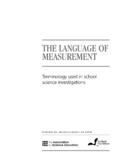Transcription of Biology fieldwork in school grounds a model of good ...
1 SchoolScienceReview,March 2006,87(320)99 HowarthandSlingsby Biology fieldworkin schoolgrounds Biology fieldwork in school grounds :amodelofgoodpracticein teaching scienceSueHowarthandDavidSlingsbyThreeca se studies whichillustratehow easily organisedoutdoor investigations canbring science tolifeABSTRACTD irect observationof theenvironment andpractical scientificenquiry outside theclassroomarefundamental toan understandingof thenature of scienceas wellas a sourceofinspirationandmotivation. Outdoor Biology is a well-developed traditionin theUKandprovides many examples ofgood practice that could profitably beextended to the teachingofother scientificdisciplines. Threecase studies are presented that illustrategood practiceinscience teaching, whilst minimisingcost andtimetabledisruptionby making useof AnthonyCampbell (Campbell,1994) has observed that manybigideas in sciencehavebeeninspiredbyobservations of thenaturalenvironment.
2 Theimages ofNewtonandhis fallingapple,Galvaniandhis twitchingfrog s legs andCharles DarwinoverwhelmedbyGalapagos biodiversitycertainlysupport this idea. Campbell s ownchildhoodfascin-ationfor bioluminescenceof glowworms andofmarine planktoninwaves breakingon the shoreledhim toelucidate theunderlyingbiochemistryofthe process. This,in turn,ledhim to makeamajor breakthroughindiagnosticmedicine (Campbell,1988).All science,chemistryand physics as wellas Biology ,cancomealivebygettingout of theclassroom. Indeed, science that does not make theconnectionbetweenlookinginwonder at thenaturalworldand scientificenquiryis incomplete. Makingsuchaconnectionis anessential part ofunderstandingscienceas anintellectual process. Newton,GalvaniandDarwinhavelong since passedaway,but their sourceofinspiration still remains at least partly outside of reasons whyfewer classes experienceoutdoor science thanused tobe the case.
3 Theseare discussedbyBarker,SlingsbyandTilling(200 2) andincludeconcerns about healthand safety,expenseand timeout of thenormal school timetablefor both students and teachers. Yet these problems canbeovercomemuchmoreeasily than many think. It is a questionof where there s awill there s away . Theoutdoors has suchalot to offer scienceteaching that anymodest problems dealcanbeachieved, quiteinexpensively,in the relativelynon-hazardous environment of theschoolgrounds duringnormal timetabledlessons. Agreat advantageof this is that fieldworkcanbeincorporatedintoa sciencecourseas a series of short episodes ofoutdoor activityover a periodof time. Schoolgrounds neednot beextensive tobeusefulfor outdoor science,although thereareways inwhichtheycanbe developed toenhance their potential. Theconstructionofa pondis an obvious project worthundertaking,especiallyifit is designed to maximisebiodiversity.
4 Anareamanagedas anature reserveor studies that followhaveallbeen tried,testedandenjoyedby students and teacher alike. Fineweather is not essential, thoughdesirable:umbrellas andwaterproofs canevenadd to the differentness ofalesson!Workingeffectivelyoutdoors andinawell-organisedfashion,irrespective of theweather conditions,is something that develops withexperience. Indeed,it is important ina rangeofcareers. Someof theactivities describedherehavebeendevelopedover anumber ofyears,and the sourceof theoriginalinspirationhas beenforgotten, soifideas havebeen stolenwithout acknowledgement, pleaseaccept our apologies andtakeit as ,March 2006,87(320) Biology fieldworkin schoolgrounds HowarthandSlingsbyCase study 1:Theeffects ofabioticfactors inartificial pondsIn this activity, two (or more) recentlyestablishedor recentlycleanedout ponds indifferent locations are comparedin terms of their bioticandabioticcomponents throughopen-endedenquiry.
5 Theuseofbuckets or washing-up bowls as temporary,artificial ponds as analternativewhen real ponds arenot availableis described. The system provides ameans toinvestigate theinfluenceofabioticfactors on thesubsequent successional theactivitywouldbenefit fromaccess totwocontrasting ponds,althoughone pondwouldbequite satisfactory provided that different areas withinit canbe compared,for instanceoppositeends or shallowversus deeper water. However,ifno pondis availableanartificial systemcanbe createdusingplasticwashing-up bowls or buckets. The smaller surfaceareaofbuckets as opposed tobowls means that not onlyis water loss byevaporation reducedbut also the rateat whichoxygencandiffuse throughthewater surfacefrom theair. Bothbucket andbowlcontainingequaldepths ofwater couldbe set up in the samearea tocompare the effect of surfaceareaon the rateofevaporation. Alternatively, twoidenticalbuckets containingequalvolumes ofwater couldbeleft indifferent areas that arenot likely tobedisturbed.
6 In schools wherevandalismis a p roblemthebuckets couldbe placedonaflat roof, providedthat this canbe done procedureForward planningis needed todecidelocations touseandwhen to set up ponds . Theycouldbeset up before the summer holidays andcheckedintheautumn term. If tap water is useda periodofat least amonthis usuallyneeded toallow timefor bird/air-bornematerial to reach the pondandgrowsufficiently tobe detectedandlivingorganisms seen. This couldbekept as an on-going project,with samples being takenandlookedat under microscopes at regular intervals andalogbeingkept. Theconcepts of p rimary successioncouldbestudiedbyA-level students (16 18year-olds). Theopticaldensityof thewater shouldincreaseas thebiomass accumulates andanimallife shouldincreaseas primary producers locations,ifchosenwell,arelikely tohavedifferent abioticandbioticfactors suchas:lshade/light exposure;laspect;lfrequencyofvisits byflyinganimals;lquantityofair-bornemate rialdeposited(droppingleaves, seeds, pollen,bird-droppedmaterial/guano; theappearanceand proliferationof s pecies couldinvolve theuseofmicroscopes.)
7 Colorimeters canbeused to monitor deviationin opticaldensityfromafresh tap-water sample. Thewater develops agreencolorationandopticaldensityincreas es surprisingly quicklyas biomass accumulates. Thelevelof s pecies identificationand the degreeofqualitativeness willdependon fair test,withonly thelocationchanging,wouldhelp to set the sceneandget thestudents involvedin settingup results willbeobtainedinwarmer weather,but careneeds tobe taken toavoidtheartificial ponds dryingup. Inwarmweather meaningful results canbeobtainedinas littleas slotTo fit in with any part of the curriculum dealing withadaptations to theenvironment,ecologicalchangeand theeffect ofabioticfactors. EnglishNationalCurriculum (QCA, 2004) key stages 3,4and5 (ages 11 18).Figure 1 Using real ponds to study ,March 2006,87(320)101 HowarthandSlingsby Biology fieldworkin schoolgrounds ResourcesThefollowingwillbeneededor useful:lponds or buckets/bowls;lcollectingbottles for sampling;ldisposable plasticgloves;lmicroscopes for lookingfor livingmaterial;lcolorimeter ifavailable;lguides/keys for identification (see especially theFieldStudies CouncilFreshwater name trail seewebsites).
8 Points tonotein riskassessmentHowlikelyare people tofallin the pond? Is there safeaccess? Thereis avery small riskofWeil s diseasewhenusing real ponds althougha school pondis most unlikely tobeaffectedby rats urine. Makingsureopencuts in thehands are coveredwith plasters,disposable plasticgloves arewornwhilst handlingpondwater and that thereis effectivehand-washingafterwards arewise precautions shouldgain:lanappreciationof the effect ofabioticfactors onecologicalchange;lawareness that freshwater organisms aredispersed tonewhabitats;lanunderstandingof successionbasedonanexample that theyhave seenfor study 2:Succession plotsIn this study, smallareas oflandare clearedofvegetationandobservedover anumber ofyears sothat successioncanbe most schools it is important todiscuss theselectionofa suitable patchof ground tobeleft untendedwith the senior management teamandtheground staff,and togain their agreement.
9 Asignexplaining the purposeof the plots is not onlyinformativefor other students and parents,but emphasises the serious scientificnatureof thework(Figure2).Muchcanbeachievedwith quitea smallexperimentalarea. In this case study-plots ofonesquaremetrewereused. In 1999,16/17 year-oldstudents dugand cleared two plots,oneoneither sideof the scienceblock. Eachyear since thenanother plot has beenadded, resultingina series of plots onone sideof thebuilding, rangingfrom0 7 years oldand two plots,both 7 years old,oneither sideof thebuilding. Corner markers (white painted posts) showclearly the plot boundaries and thegardeners mowround the procedureStudents needhelp with species identification. Pressedleaves andflowers collectedandnamedin p revious years areusefulas referencematerial. Thefold-out identificationcharts availablefrom theFieldStudies Council (see Resources ) may anappropriatemethodof recordingquadrats, suchas percentagefrequency, percentagecover or individualcounts.
10 Individualcounts canbeused tocalculatediversityindices. Tomakefair comparisons,as far as possible recordings shouldbemadeat the same time eachyear. Wehavefound that the two plots dug 7 years agocontinue tobeverydifferent fromeachother,withcontrastingindices ofdiversity. Drawings or photographs to show thedistributionof plants canalso proveuseful. TheycanbemergedusingPowerPoint,or as acetateoverlays onan overhead projector, to showchangeover time. For further informationabout field techniques see theBritishEcologicalSocietywebsite (seewebsites).Curriculum slotA-levelbiology (ages 17 18,optionalinEnglandandWales).Figure 2 Succession ,March 2006,87(320) Biology fieldworkin schoolgrounds HowarthandSlingsbyOur plots havebeenmadeandmonitoredeveryJulywhen thegroundis soft todigand theweather is usuallygood. Adding plots eachyear has extended the studyof succession. It was particularlypleasingwhen threeyears agoa t ree saplingmadeanappearanceinacleared useful:ldigging tools for new plots;lpressed specimens from previous years;lidentificationguides for recordingflora (seeespecially theFieldStudies Councilfold-out charts Grassland plants(1and2) andPlayingfield plants seewebsites);lblank record sheets,listingexpected species,couldbeusedeachyear;lquadrat tonotein riskassessmentStudents need tobemadeawareof theusualgardenhazards.


